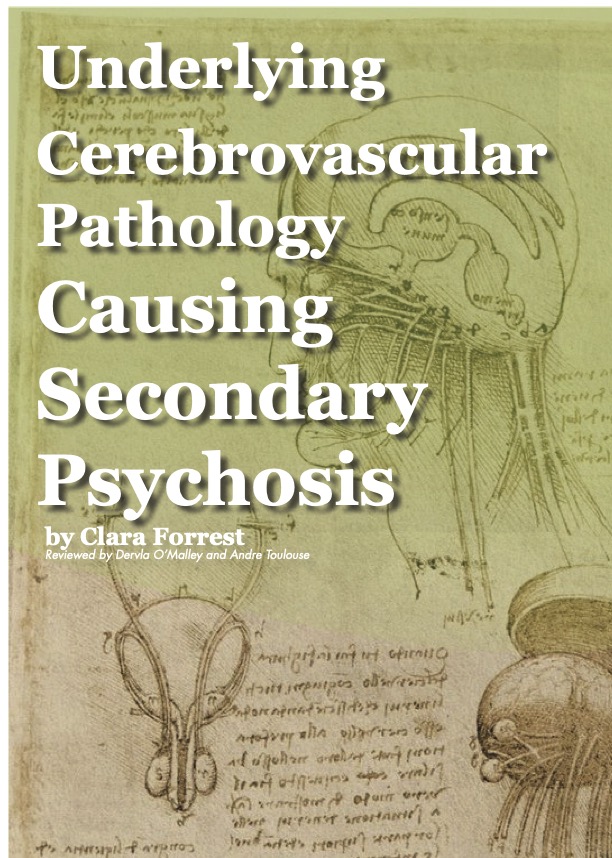Underlying cerebrovascular pathology causing secondary psychosis
DOI:
https://doi.org/10.33178/SMJ.2021.1.6Keywords:
cerebrovascular, secondary psychosisAbstract
Case Background
Psychosis can be classified as primary if it is caused by a psychiatric disorder or secondary if it is due to a specific medical condition. Despite there being multiple identified causes of secondary psychosis, making such a diagnosis can prove challenging.
Case Details
This case report presents a 57-year-old male who was brought by ambulance to the emergency department following an intentional jump from a first story window due to visual and auditory hallucinations and persecutory paranoid delusions. MRI findings on admission were consistent with cerebral autosomal dominant arteriopathy with subcortical infarcts and leukoencephalopathy (CADASIL). The patient’s background included an ischaemic stroke with haemorrhagic transformation five years previously. He experienced psychotic symptoms during the immediate recovery period. Prior to this he had no psychiatric history.
Discussion
Post-stroke psychosis and the condition of CADASIL are both entities that are relatively rarely described in the literature. However, this may be due to missed diagnosis and therefore not reflective of true prevalence.
Conclusion
Identifying a cause-effect relationship and establishing a diagnosis of secondary psychosis can be confounded by many factors. Nevertheless, this patient’s case demonstrates the importance of considering an underlying cause, particularly when the presentation is atypical and there is a temporal relationship between the proposed medical condition and the symptoms of psychosis.
Patient Consent Obtained: Yes
References
Rössler W, Salize HJ, van Os J, Riecher-Rössler A. Size of burden of schizophrenia and psychotic disorders. Eur Neuropsychopharmacol. 2005;15(4):399-409.
Reed GM, First MB, Kogan CS, Hyman SE, Gureje O, Gaebel W, et al. Innovations and changes in the ICD-11 classification of mental, behavioural and neurodevelopmental disorders. World Psychiatry. 2019;18(1):3-19.
Joyce EM. Organic psychosis: The pathobiology and treatment of delusions. CNS Neurosci Ther. 2018;24(7):598-603.
Keshavan MS, Kaneko Y. Secondary psychoses: an update. World Psychiatry. 2013;12(1):4- 15.
Miller BL, Lesser IM, Boone K, Goldberg M, Hill E, Miller MH, et al. Brain white-matter lesions and psychosis. Br J Psychiatry. 1989;155:73-8.
WHO Mental Health Gap Action Programme (mhGAP) Intervention Guide. World Health Organization; 2016.
Stangeland H, Orgeta V, Bell V. Poststroke psychosis: a systematic review. J Neurol Neurosurg Psychiatry. 2018;89(8):879-85.
Tournier-Lasserve E, Joutel A, Melki J, Weissenbach J, Lathrop GM, Chabriat H, et al. Cerebral autosomal dominant arteriopathy with subcortical infarcts and leukoencephalopathy maps to chromosome 19q12. Nat Genet. 1993;3(3):256-9.
Lagas PA, Juvonen V. Schizophrenia in a patient with cerebral autosomally dominant arteriopathy with subcortical infarcts and leucoencephalopathy (CADASIL disease). Nord JPsychiatry. 2001;55(1):41-2.
Ho CS, Mondry A. CADASIL presenting as schizophreniform organic psychosis. Gen Hosp Psychiatry. 2015;37(3):273.e11-3.
Mishra DK, Kishore A, Niranjan V. CADASIL syndrome (cerebral autosomal dominant arteriopathy with subcortical infarcts and leukoencephalopathy) presenting as psychosis. Gen Psychiatr. 31. England2018. p. e100017.

Downloads
Published
License
Copyright (c) 2024 Clara Forrest

This work is licensed under a Creative Commons Attribution-NonCommercial 4.0 International License.









